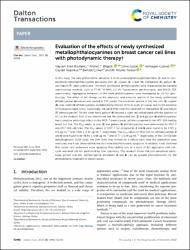| dc.description.abstract | In this study, the new phthalonitrile derivative 3-(4-(3-oxobutyl)phenoxy)phthalonitrile (1) and its nonperipheral
metallophthalocyanine derivatives [zinc (2), copper (3), cobalt (4), manganese (5), gallium (6),
and indium (7)] were synthesized. The newly synthesized phthalocyanines were characterized by standard
spectroscopic methods, such as FT-IR,
1
H NMR, UV-Vis, fluorescence spectroscopies, and MALDI-TOF
spectrometry. Aggregation behaviors of the novel phthalocyanines were investigated by UV-Vis spectroscopy.
The effect of pH change on the electronic and emission spectra of the newly synthesized
phthalocyanine derivatives was studied in THF media. The electronic spectra of the new zinc (2), copper
(3), and cobalt (4) phthalocyanines exhibited bathochromic shifts in acidic pH values due to the presence
of monoprotonated forms. Surprisingly, the same effect was not observed for manganese (5) and indium
(7) phthalocyanines. On the other hand, gallium (6) showed a slight red-shifted band with the addition of
HCl to the medium. Also, it was determined that the synthesized zinc (2) and gallium (6) phthalocyanines
had a selective phototoxic effect on the MCF-7 breast cancer cell line compared to the MCF-10A healthy
breast cell line. The IC
values of zinc (2) and gallium (6) phthalocyanines were determined for MCF-7
and MCF-10A cell lines. The IC
50
values of MCF-7 for compounds 2 and 6 were found to be 1.721 ±
0.4 µg mL
−1
50
and 7.406 ± 0.32 µg mL
−1
values of MCF-10A for phthalocyanines 2
and 6 were found to be 48.90 ± 0.69 µg mL
, respectively. The IC
−1
50
and 14.77 ± 1.09 µg mL
−1
, respectively. In the LDH (lactate
dehydrogenase)-ELISA study, the LDH levels that formed on a cellular basis after the application were
measured, and it was observed that the cells were directed towards apoptosis. In addition, it was observed
that cancer cells underwent more apoptosis than healthy cells as a result of this application with cellcycle
and dead cell kits performed by flow cytometry. This research shows that non-peripheral substituted
gallium and zinc phthalocyanine derivatives (2 and 6) can be suitable photosensitizers for the
photodynamic treatment of breast cancers. | tr |















